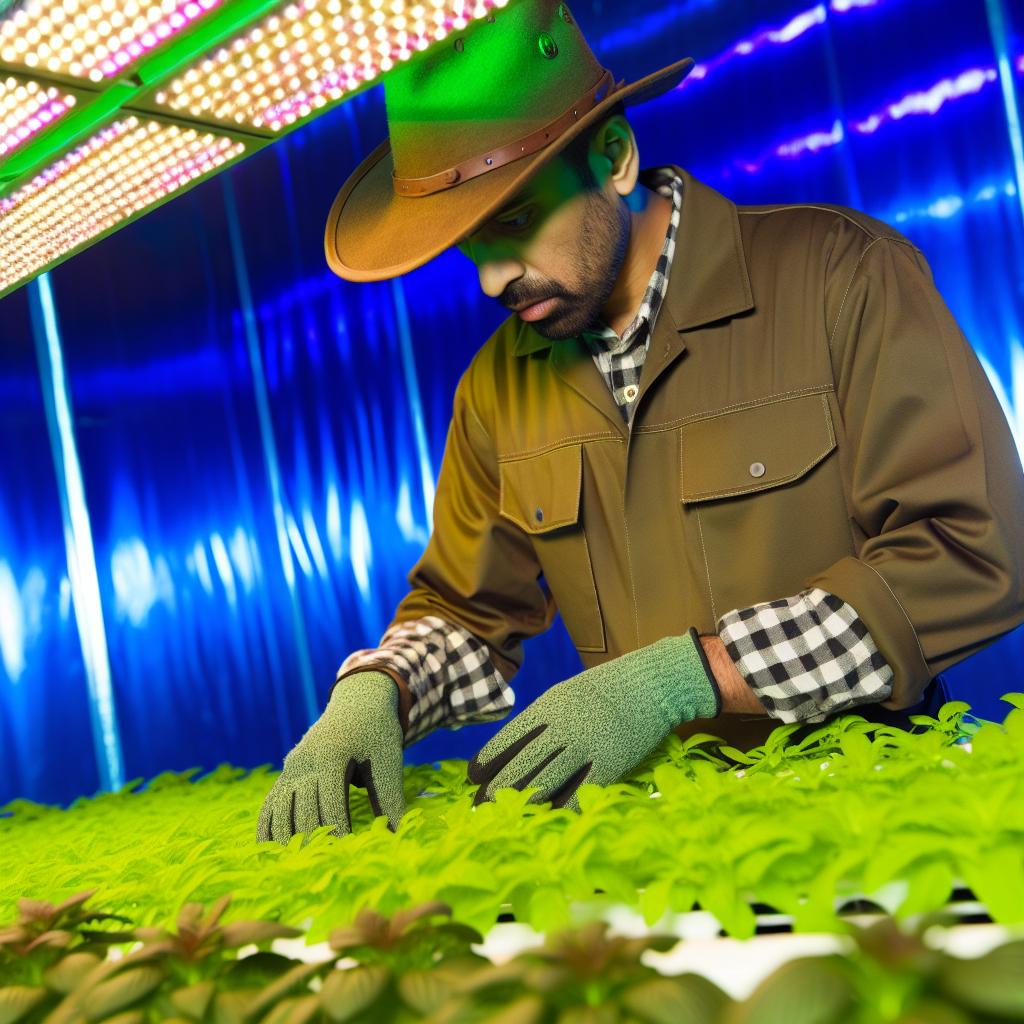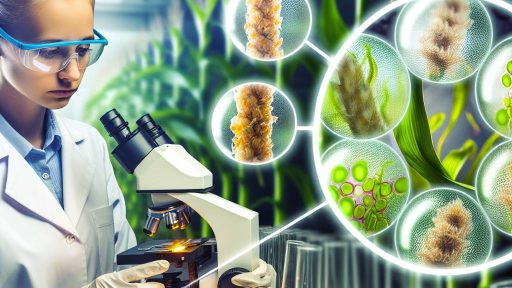Introduction to Sustainable Farming Practices
Sustainable farming practices focus on producing food while protecting the environment.
These methods aim to maintain ecological balance and biodiversity.
Farmers increasingly adopt sustainable techniques to ensure future food security.
Essentials of Sustainable Practices
Sustainable practices incorporate various approaches to farming.
Crop rotation helps in maintaining soil health.
Use of cover crops prevents soil erosion and enhances fertility.
Moreover, integrated pest management reduces chemical usage.
Employing organic farming methods boosts soil biodiversity.
Benefits of Controlled Environment Systems
Controlled environment systems are innovative solutions for farming challenges.
These systems allow for precise control over growing conditions.
Farmers can optimize water and nutrient use for crops.
Thus, they minimize waste and improve yield consistency.
In addition, these systems can significantly reduce the need for pesticides.
Innovative Techniques and Technologies
Technological advancements enhance sustainable farming practices.
Hydroponics provides a soil-less method for growing plants.
Transform Your Agribusiness
Unlock your farm's potential with expert advice tailored to your needs. Get actionable steps that drive real results.
Get StartedAeroponics, another advanced technique, uses misting to deliver nutrients.
Vertical farming maximizes space efficiency, using less land.
These innovative systems positively impact sustainability efforts.
Community and Economic Impact
Sustainable farming supports local economies through job creation.
Additionally, it promotes healthier food options for communities.
Farmers can benefit economically by reducing input costs.
The growth of sustainability-focused markets opens new opportunities.
Challenges and Future Directions
Despite the advantages, challenges remain in adopting sustainable practices.
Initial setup costs for controlled environment systems can be high.
Furthermore, education is crucial for farmers to adopt new technologies.
As sustainability gains traction, more funding and support are necessary.
Continuous research will drive future innovations in sustainable farming.
Overview of Controlled Environment Systems
Definition and Purpose
Controlled Environment Systems (CES) offer a unique farming approach.
They maintain optimal growing conditions for plants.
This system regulates temperature, humidity, and light.
Consequently, it maximizes crop yields throughout the year.
Types of Controlled Environment Systems
Several types of CES exist in modern agriculture.
For instance, greenhouses provide natural light with climate control.
Hydroponic systems grow plants in nutrient-rich water solutions.
Moreover, vertical farms utilize vertical space for dense crop production.
Benefits of Controlled Environment Systems
CES offers multiple advantages to farmers and the environment.
First, these systems enhance resource efficiency significantly.
Water consumption decreases due to precise irrigation methods.
Subsequently, energy consumption can also be managed effectively.
Showcase Your Farming Business
Publish your professional farming services profile on our blog for a one-time fee of $200 and reach a dedicated audience of farmers and agribusiness owners.
Publish Your ProfileSecond, CES reduces the use of pesticides.
This approach leads to healthier crops and fewer chemicals in agriculture.
Additionally, controlled environments minimize disease and pest outbreaks.
Challenges Faced by Controlled Environment Systems
Despite their benefits, CES presents some challenges.
Initial setup costs can be high for farmers.
It requires a significant investment in technology and infrastructure.
Furthermore, ongoing energy costs must be managed carefully.
Farmers need to adopt renewable energy sources for sustainability.
Lastly, technical expertise is often necessary for optimal operation.
Future Trends in Controlled Environment Systems
Looking forward, CES will likely evolve with advanced technologies.
Automation and artificial intelligence will enhance efficiency.
Moreover, data analytics can optimize growing conditions in real time.
As environmental concerns grow, sustainable practices will gain importance.
This drive will encourage further innovations in CES.
Overall, Controlled Environment Systems promise a sustainable agricultural future.
Benefits of Using Controlled Environment Systems in Sustainable Farming
Optimized Resource Use
Controlled Environment Systems (CES) maximize resource efficiency.
They enable precise control over water, nutrients, and temperature.
This precision reduces waste and conserves vital resources.
Farmers can grow more food with less input through CES.
Consequently, they reduce their overall environmental footprint.
Enhanced Crop Yields
CES provides an ideal growing environment year-round.
This consistency leads to higher and more reliable crop yields.
Farmers can harvest multiple times in a year with CES.
Moreover, they can grow a broader variety of crops.
This diversity caters to changing market demands and preferences.
Reduction of Pesticide Use
Controlled environments minimize pest intrusion significantly.
As a result, farmers often reduce or eliminate pesticide applications.
Less pesticide use promotes healthier produce for consumers.
Additionally, this practice benefits the surrounding ecosystem.
Climate Resilience
CES protects crops from adverse weather conditions.
Farmers are less vulnerable to fluctuations in climate patterns.
This resilience ensures stable food production throughout the year.
As a result, farmers can better manage risks associated with climate change.
Improved Quality of Produce
Products grown in controlled environments often have higher quality.
They exhibit better taste, texture, and nutritional value.
This quality assurance can enhance marketability and consumer trust.
Consumers increasingly seek fresh, high-quality produce.
Economic Viability
Investing in CES can yield significant financial benefits.
Initial costs may be high, but long-term savings are substantial.
Lower production costs lead to higher profit margins for farmers.
Showcase Your Farming Business
Publish your professional farming services profile on our blog for a one-time fee of $200 and reach a dedicated audience of farmers and agribusiness owners.
Publish Your ProfileAdditionally, diversified crop production opens up new revenue streams.
Explore Further: Solar Irrigation Solutions for Efficient Water Use
Key Technologies Employed in Controlled Environments
Hydroponics and Aeroponics
Hydroponics eliminates the need for soil cultivation.
This system delivers nutrients directly to plant roots.
Aeroponics enhances this by misting roots with nutrient-rich water.
Both techniques increase crop growth rates significantly.
Climate Control Systems
Climate control is crucial for maintaining optimal conditions.
Temperature, humidity, and light intensity can be precisely managed.
This technology ensures consistent crop yields throughout the year.
Moreover, it reduces the risk of disease and pest infestations.
LED Lighting
LED lighting provides energy-efficient illumination for plants.
It offers the spectrum needed for photosynthesis.
Furthermore, LED lights can be tuned to specific growth stages.
This flexibility enhances productivity in controlled environments.
Automated Systems
Automation simplifies the management of controlled environment farms.
It allows for real-time monitoring and adjustments.
Automated irrigation systems optimize water usage significantly.
This helps conserve resources while improving crop quality.
Data Analytics and AI
Data analytics streamlines operational efficiency in farming.
AI can predict optimal planting and harvesting times.
This technology also identifies potential problems early on.
Consequently, farmers can make informed decisions quickly.
Find Out More: Benefits Of Genetically Modified Crops For Modern Farmers
Water Management Techniques in Controlled Environment Farming
Importance of Water Efficiency
Water efficiency stands as a vital component in controlled environment farming.
This technique conserves water while maximizing crop yield.
Moreover, it reduces the risk of water scarcity.
Farmers can use targeted irrigation methods to improve efficiency.
Types of Irrigation Systems
Various irrigation systems support efficient water use.
- Drip irrigation delivers water directly to plant roots.
- Hydroponic systems use nutrient-rich water for plant growth.
- Subsurface irrigation minimizes evaporation loss.
Each method offers distinct advantages for sustainable farming.
Water Recycling Techniques
Water recycling plays a crucial role in sustainability.
Farmers can collect and reuse runoff water from their systems.
This process reduces overall water consumption significantly.
Additionally, it helps maintain optimal humidity levels inside farms.
Monitoring Water Quality
Monitoring water quality is essential for healthy crop growth.
Regular testing can prevent nutrient deficiencies or toxic buildup.
Farmers should invest in tools for real-time water quality analysis.
Employing these tools ensures healthy plants throughout the growing season.
Impact on Crop Quality and Yield
Effective water management directly influences crop quality.
Well-watered plants exhibit better growth and higher yields.
This advantage leads to increased profitability for farmers.
Showcase Your Farming Business
Publish your professional farming services profile on our blog for a one-time fee of $200 and reach a dedicated audience of farmers and agribusiness owners.
Publish Your ProfileFurthermore, it contributes positively to environmental sustainability.
Delve into the Subject: IoT-Driven Data Analytics for Farm Productivity
Soil Health and Nutrient Management in Controlled Environment Systems
Importance of Soil Health
Healthy soil is the foundation of sustainable farming.
It ensures crops receive essential nutrients, promoting growth.
Moreover, it enhances water retention, reducing irrigation needs.
Healthy soil also supports diverse microbial life.
This biodiversity contributes to nutrient cycling in the ecosystem.
Nutrient Management Strategies
Effective nutrient management is crucial in controlled environment systems (CES).
Crop rotation can optimize nutrient availability over time.
Compost and organic fertilizers enrich soil health naturally.
Additionally, precision agriculture techniques monitor nutrient levels.
These techniques enable targeted applications of fertilizers.
Utilizing Cover Crops
Cover crops play a vital role in soil conservation.
They prevent soil erosion during off-seasons.
Furthermore, cover crops enhance soil structure and fertility.
This can ultimately lead to higher crop yields.
Implementing Soil Testing
Regular soil testing identifies nutrient deficiencies.
It informs better management decisions to optimize conditions.
Through testing, farmers can apply precise amendments as needed.
Thus, they minimize waste and avoid over-fertilization.
Integrating Technology
Technology significantly enhances soil health management.
Remote sensing can evaluate soil moisture and nutrient levels.
This data allows for informed water and fertilizer applications.
Additionally, mobile applications facilitate real-time monitoring.
Farmers can adjust practices based on immediate feedback.
Adopting Soil Health Practices for Success
Adopting these soil health and nutrient management practices leads to success.
They support a sustainable approach to controlled environment agriculture.
Ultimately, healthy soil promotes resilient farming systems.
Explore Further: Drones For Efficient Irrigation Management In Farming

Pest and Disease Control Strategies in Controlled Environments
Integrated Pest Management
Integrated Pest Management (IPM) combines multiple strategies to control pests effectively.
Firstly, it involves monitoring pest populations to make informed decisions.
This approach reduces reliance on chemical pesticides.
For instance, farmers can introduce beneficial insects that prey on harmful pests.
Moreover, using physical barriers, like nets, effectively prevents pest access.
Biological Control Methods
Biological control methods enhance natural mechanisms to manage pests.
Farmers can cultivate predator species that reduce pest numbers naturally.
For example, ladybugs can significantly lower aphid populations.
Additionally, fungi and bacteria can be deployed to combat specific pests and diseases.
These methods promote ecological balance within controlled environments.
Cultural Control Practices
Cultural practices play a vital role in pest management strategies.
Showcase Your Farming Business
Publish your professional farming services profile on our blog for a one-time fee of $200 and reach a dedicated audience of farmers and agribusiness owners.
Publish Your ProfileCrop rotation disrupts pest life cycles, reducing their populations.
Furthermore, selecting pest-resistant plant varieties minimizes potential infestations.
Proper sanitation within growing areas also deters pest establishment.
Regularly removing debris and old crops prevents disease spread.
Monitoring and Early Detection
Vigilant monitoring and early detection strategies are crucial.
Farmers should regularly inspect crops for signs of pests and diseases.
Using traps can help identify and track pest populations effectively.
Implementing technology, such as sensors, provides real-time data.
This information enables timely interventions to safeguard crops.
Use of Controlled Environment Technologies
Controlled environment technologies provide significant advantages.
Hydroponics and aquaponics systems minimize soil-borne diseases.
Adjustable climate controls can deter pests by creating unfavorable conditions.
Furthermore, proper humidity and temperature management reduce disease occurrence.
This technology ensures high-quality produce while maintaining sustainability.
Case Studies of Successful Sustainable Farming Using Controlled Environment Systems
Innovative Greenhouse Technology at EcoFarm
EcoFarm implemented advanced greenhouse technology to enhance crop production.
They utilized transparent solar panels to harness renewable energy.
This innovation significantly reduced their reliance on fossil fuels.
Moreover, EcoFarm integrated hydroponic systems for efficient water use.
This method allowed for the cultivation of high-yield crops year-round.
Vertical Farming Success at Urban Agri Solutions
Urban Agri Solutions transformed an abandoned building into a vertical farm.
This initiative optimized space and reduced the carbon footprint of agriculture.
It employed LED lighting systems to boost plant growth indoors.
Furthermore, this farm used rainwater harvesting systems to conserve water.
As a result, Urban Agri Solutions produced fresh produce within city limits.
Data-Driven Farming at SmartCrop Innovations
SmartCrop Innovations leveraged data analytics to enhance farming practices.
They utilized sensor technology to monitor soil conditions in real-time.
This approach enabled precise irrigation and nutrient application.
Consequently, SmartCrop achieved improved crop yields and reduced waste.
Their methods proved highly effective in maximizing resource use efficiency.
Community Impact Through Local Harvest Farms
Local Harvest Farms dedicated itself to establishing community-based agriculture.
They implemented controlled environment systems to grow organic vegetables.
This initiative provided fresh produce to local markets and restaurants.
Additionally, Local Harvest Farms organized workshops on sustainable practices.
As a result, they fostered a greater understanding of food production among community members.
Challenges and Limitations of Controlled Environment Systems
High Initial Costs
Implementing controlled environment systems often requires significant upfront investment.
Costs include technology, installation, and infrastructure upgrades.
Thus, many farmers struggle to finance these systems initially.
Technical Expertise Required
Operating controlled environment systems demands specialized knowledge and skills.
Farmers must understand climate control, nutrient management, and technology integration.
This need for expertise can limit adoption among less experienced farmers.
Showcase Your Farming Business
Publish your professional farming services profile on our blog for a one-time fee of $200 and reach a dedicated audience of farmers and agribusiness owners.
Publish Your ProfileEnergy Dependence
Controlled environment systems are typically energy-intensive.
Many systems rely on electricity for climate control and lighting.
This can lead to increased operational costs and environmental concerns.
Limited Crop Variety
Not all crops thrive in controlled environments.
Some species require specific conditions that are difficult to replicate.
Consequently, farmers may find their options for cultivation limited.
Environmental Impact
Although controlled systems aim for sustainability, they can have unforeseen impacts.
For instance, high energy consumption may result in increased carbon footprints.
Moreover, water and waste management issues can arise if not properly managed.
Maintenance Challenges
Maintaining controlled environment systems can be complex and time-consuming.
Farmers must regularly monitor equipment and systems for optimal performance.
Failure to do so can lead to crop losses and decreased yield quality.
Future Trends in Sustainable Farming with Controlled Environments
Advancements in Technology
Technology continues to play a vital role in sustainable farming.
Innovations in hydroponics and aeroponics enhance plant growth.
These systems maximize space and resource efficiency.
Moreover, automation improves labor efficiency and reduces waste.
Data analytics aids in making informed farming decisions.
Integration of Renewable Energy
Renewable energy sources increasingly power controlled environment systems.
Solar panels and wind turbines provide clean energy options.
Using renewable energy decreases the carbon footprint significantly.
This shift promotes long-term sustainability within the agricultural sector.
Increase in Urban Farming
Urban farming is gaining popularity as cities grow.
Controlled environments fit well in urban settings.
Rooftops and vacant lots transform into productive gardens.
These initiatives enhance food security in densely populated areas.
Focus on Soil Health
An emphasis on soil health is crucial for sustainable practices.
Controlled environments can help monitor and improve soil conditions.
By integrating organic practices, farmers can enrich soil biodiversity.
This focus leads to healthier crops and ecosystems.
Community Engagement and Education
Community involvement is essential for the success of sustainable practices.
Educational programs raise awareness about controlled environments.
These initiatives foster a deeper understanding of sustainable farming.
By engaging communities, farmers can share knowledge and resources.
Global Cooperation in Agricultural Research
Cooperation among nations will drive agricultural research forward.
Sharing resources and findings enhances global food systems.
This collaboration leads to innovations that benefit all countries.
Collective efforts will address challenges in sustainable farming.




